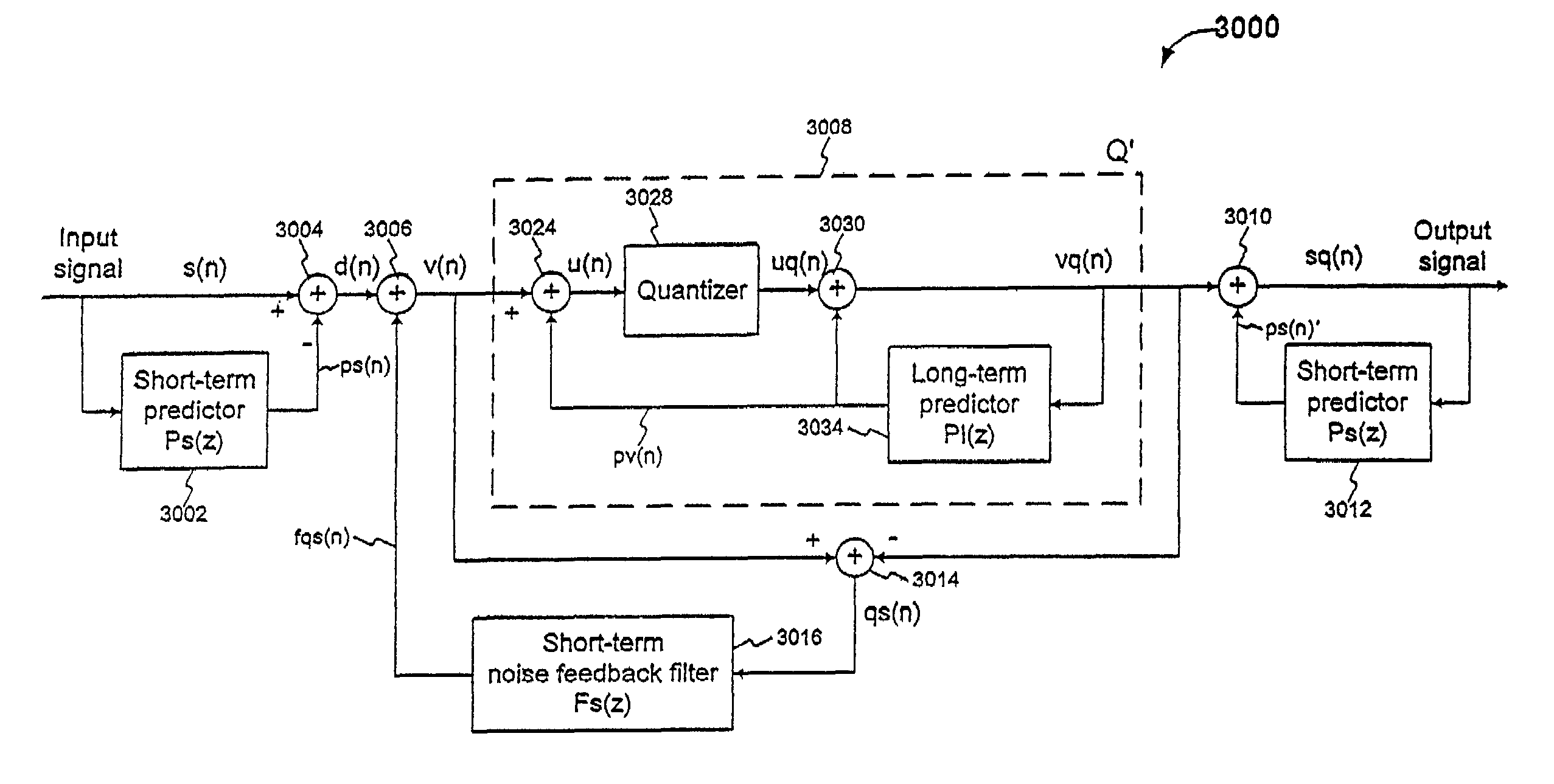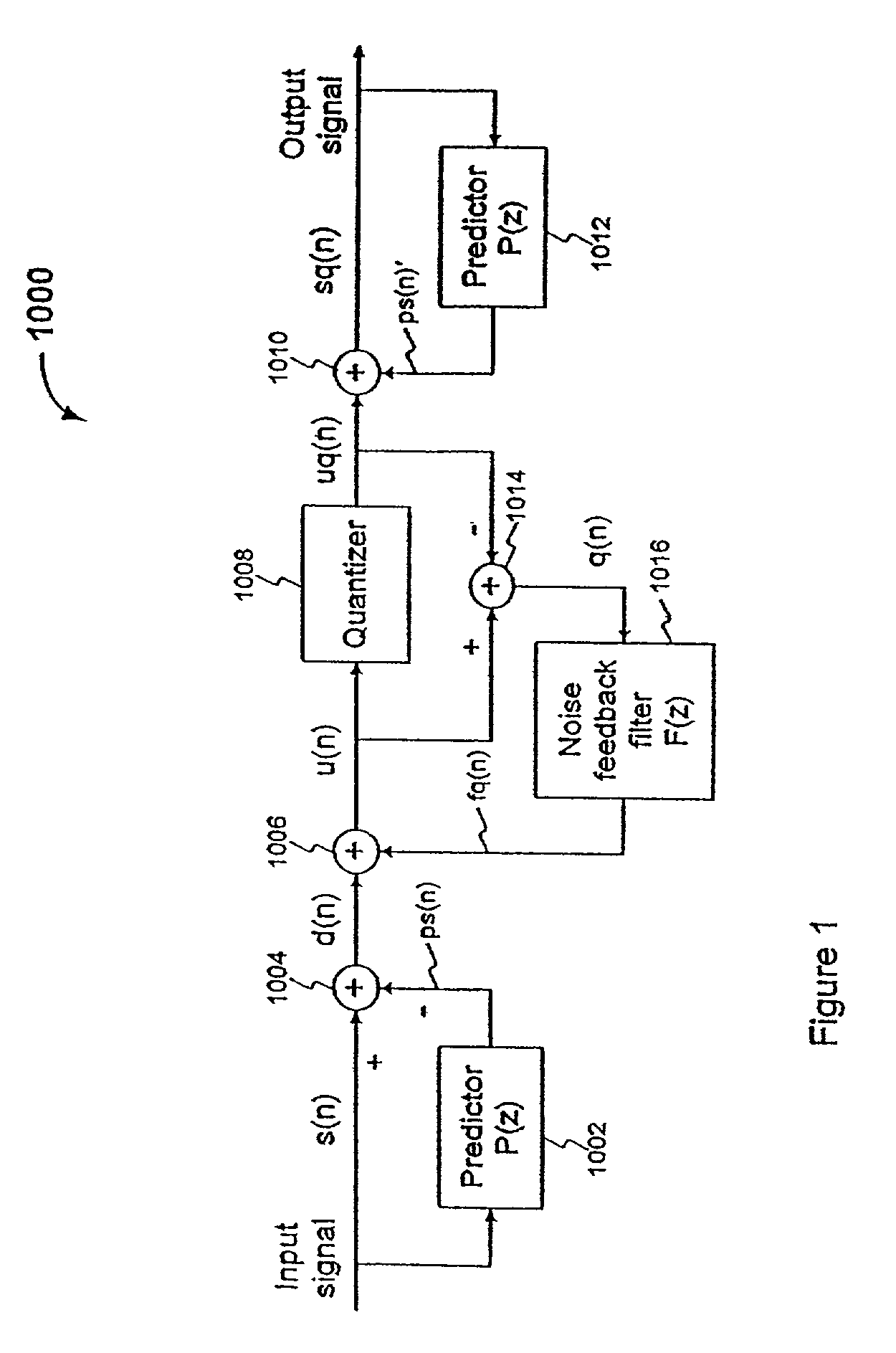Efficient excitation quantization in noise feedback coding with general noise shaping
a general noise shaping and excitation quantization technology, applied in the field of digital communication, can solve the problems of inability to fully understand the speech and/or audio signal, and the excitation vq can be relatively complex when, and achieve the effect of reducing the above mentioned audible nois
- Summary
- Abstract
- Description
- Claims
- Application Information
AI Technical Summary
Benefits of technology
Problems solved by technology
Method used
Image
Examples
##c embodiment
[0156]1. First Codec Embodiment—Composite Codec
[0157]FIG. 1A is a block diagram of an example NFC structure or codec 1050 using composite short-term and long-term predictors P′(z) and a composite short-term and long-term noise feedback filter F′(z), according to a first embodiment of the present invention. Codec 1050 reuses the general structure of known codec 1000 in FIG. 1, but replaces the predictors P(z) and filter of codec 1000 F(z) with the composite predictors P′(z) and the composite filter F′(z), as is further described below.
[0158]1050 includes the following functional elements: a first composite short-term and long-term predictor 1052 (also referred to as a composite predictor P′(z)); a first combiner or adder 1054; a second combiner or adder 1056; a quantizer 1058; a third combiner or adder 1060; a second composite short-term and long-term predictor 1062 (also referred to as a composite predictor P′(z)); a fourth combiner 1064; and a composite short-term and long-term noi...
example specific embodiment
[0344]2. Example Specific Embodiment
[0345]a. System
[0346]FIG. 13C is a block diagram of a portion of an example codec structure or system 1362 used in a prediction residual VQ codebook search of TSNFC 5000 (discussed above in connection with FIG. 5). System 1362 includes scaled VQ codebook 5028a, and an input vector deriver 1308a (a specific embodiment of input vector deriver 1308) configured according to the embodiment of TSNFC 5000 of FIG. 5. Input vector deriver 1308a includes essentially the same feedback structure involved in the quantizer codebook search as in FIG. 7, except the shorthand z-transform notations of filter blocks in FIG. 5 are used. Input vector deriver 1308a includes an outer or first stage NF loop including NF filter 5016, and an inner or second stage NF loop including NF filter 5038, as described above in connection with FIG. 5. Also, all of the filter blocks and adders (combiners) in input vector deriver 1308a operate sample-by-sample in the same manner as de...
example specific
[0372]2. Example Specific Embodiments
[0373]a. ZERO-INPUT Response
[0374]FIG. 14C is a block diagram of an example ZERO-INPUT response filter structure 1402a (a specific embodiment of filter structure 1402) used during the calculation of the ZERO-INPUT response of q(n) of FIG. 13C. During the calculation of the ZERO-INPUT response vector qzi(n), certain branches in FIG. 13C can be omitted because the signals going through those branches are zero. The resulting structure is depicted in FIG. 14C. ZERO-INPUT response filter structure 1402a includes filter 5038 associated with an inner NF loop of the filter structure, and filter 5016 associated with an outer NF loop of the filter structure.
[0375]The method of operation of codec structure 1402a can be considered to encompass a single method. Alternatively, the method of operation of codec structure 1402a can be considered to include a first method associated with the inner NF loop of codec structure 1402a, and a second method associated wi...
PUM
 Login to View More
Login to View More Abstract
Description
Claims
Application Information
 Login to View More
Login to View More - R&D
- Intellectual Property
- Life Sciences
- Materials
- Tech Scout
- Unparalleled Data Quality
- Higher Quality Content
- 60% Fewer Hallucinations
Browse by: Latest US Patents, China's latest patents, Technical Efficacy Thesaurus, Application Domain, Technology Topic, Popular Technical Reports.
© 2025 PatSnap. All rights reserved.Legal|Privacy policy|Modern Slavery Act Transparency Statement|Sitemap|About US| Contact US: help@patsnap.com



